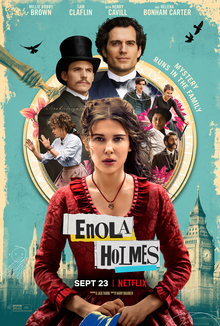‘Enola Holmes’: A one-woman show of a film

“Enola Holmes” tells the story of Sherlock Holmes’ younger sister Enola.
September 29, 2020
For a star known as being wise beyond her years, Millie Bobby Brown perfectly captures youthful exuberance in her latest role as Enola Holmes, younger sister to Sherlock Holmes. Despite taking place in the same universe, “Enola Holmes” strays far from traditional stories about Sherlock Holmes and makes it clear that, just like Enola, it’s paving its own path, different than any before it. The first film, based on a five book series, sets the groundwork for what could become a successful and long-running franchise.
Enola is decades younger than her brothers and grows up in a remote countryside home with her widowed mother (Helena Bonham Carter). The isolation does not equate to loneliness for the child, as her mother teaches her science, literature, jujitsu and how to “watch and listen.” Her older brother’s detective skills become evident in her when she wakes up on her 16th birthday only to find that her mother is gone. Immediately she starts searching for clues, and we meet her already more famous brothers Sherlock (Henry Cavil) and Mycroft (Sam Clafin).
Brown’s talents begin to shine once Cavil and Clafin enter the film. Enola’s wit and charm, emphasized by her humorous side comments directly to the audience, immediately make both her brothers’ presence dull. Sherlock is warm but ultimately useless and the definition of vanilla. Mycroft is more entertaining as the outspoken misogynist, but eventually, his remarks become redundant and annoying, making me grateful for his limited screen time. Sherlock finds Enola’s rebellious and outspoken nature amusing, while Mycroft sees it as something to erase. Enola doesn’t care and sets off to London to find her mother. On the train, she meets the Viscount Tewkesbury (Louis Partridge) who, like all males in this film, lacks any emotional range or intrigue.
The lack of character development for anyone serves as a benefit to ensure that the audience pays close attention to Enola. The movie is wholly about her, so much so that any scene without her is painfully boring. She guides us all around England from her beautiful serene country home to the sea of bland brown buildings known as London. The cinematography, like the entire film, is guided by Enola, and it mainly comprises of the camera following her, with very few unique or adventurous shots.
“Enola Holmes” offers the ultimate form of escapism. It’s nice to imagine Victorian England as a place where women of color owned tea shops with secret martial arts dojos and corsets were used to block knife attacks instead of slimming waists. The stakes are low, and nobody is in extreme danger. The plot isn’t as gripping as the character, and I was more interested in what Enola would say next more than anything else.
The film, while set in the Victorian era, has clear modern parallels. Its girl power spirit and activist side plot are applicable to the current global situation. At its core, the film centers around a young woman with a mindset different from her “superiors” who wants to be better than those before her but is consistently scrutinized by traditionalists. It portrays a young person wanting to set a different path for herself and change the circumstances she’s forced into. These messages make films such as “Enola Holmes” important in today’s world.








